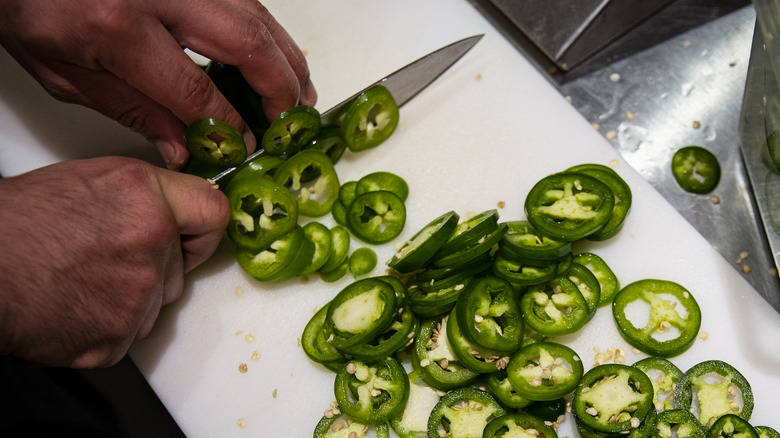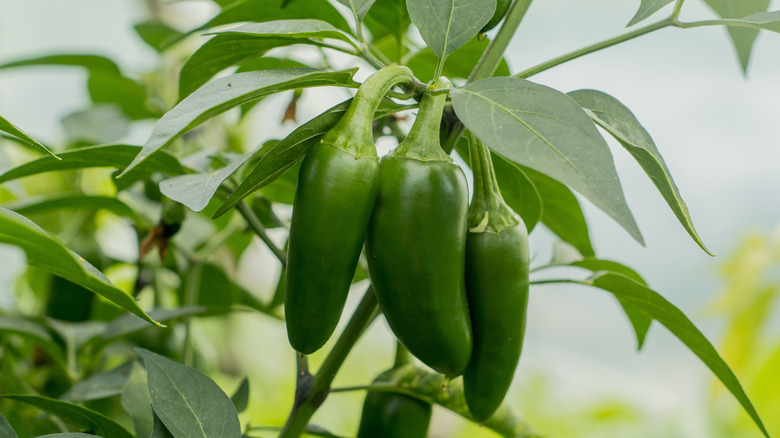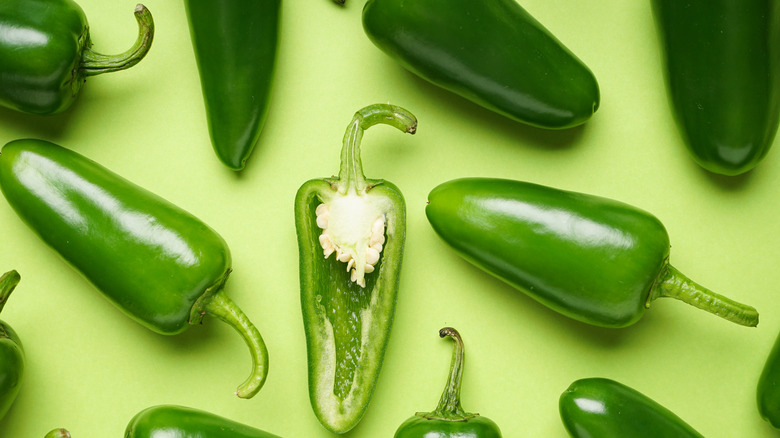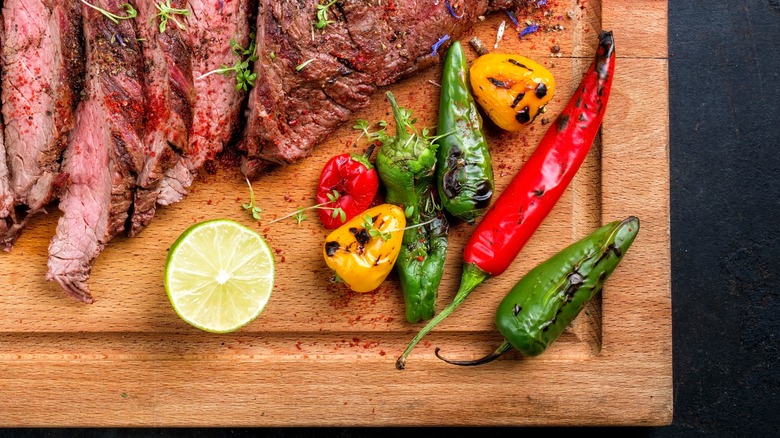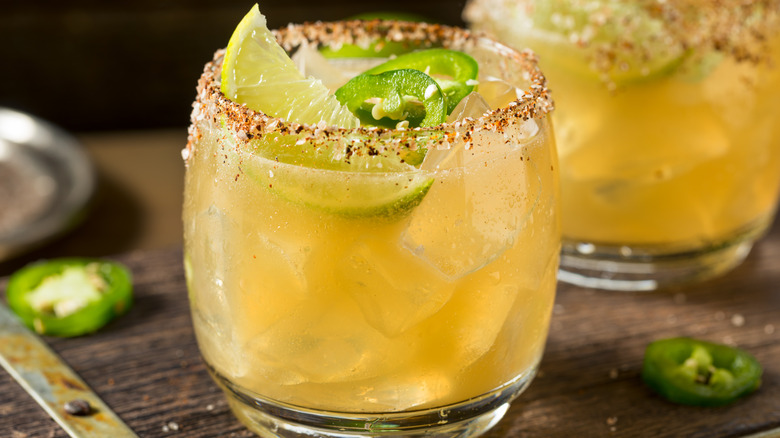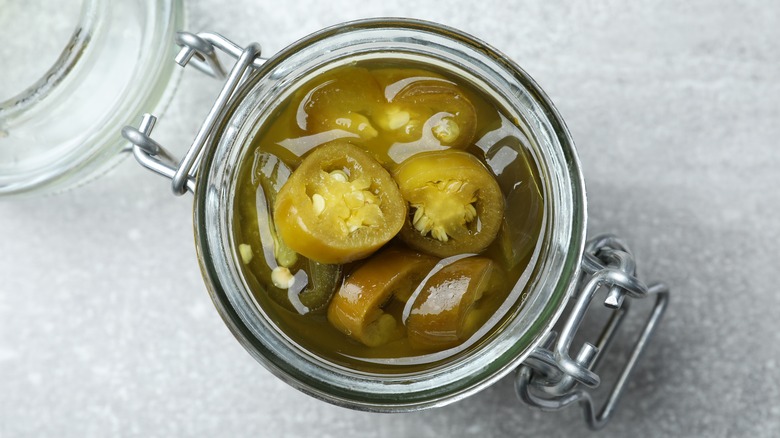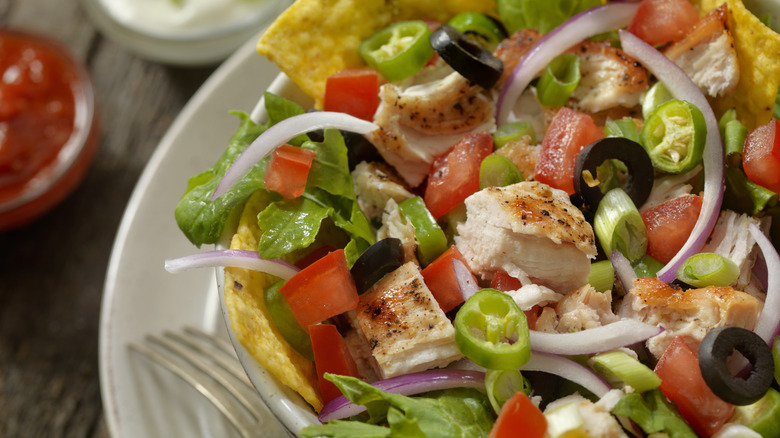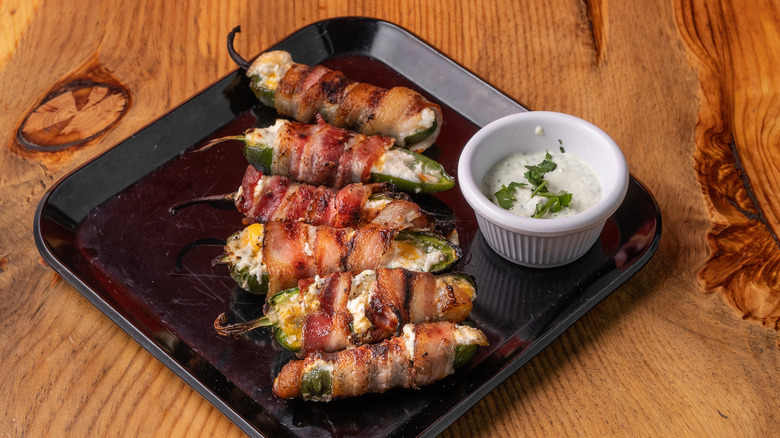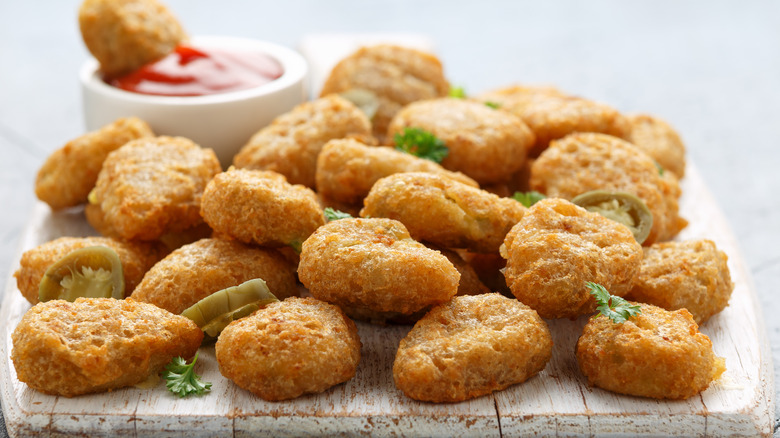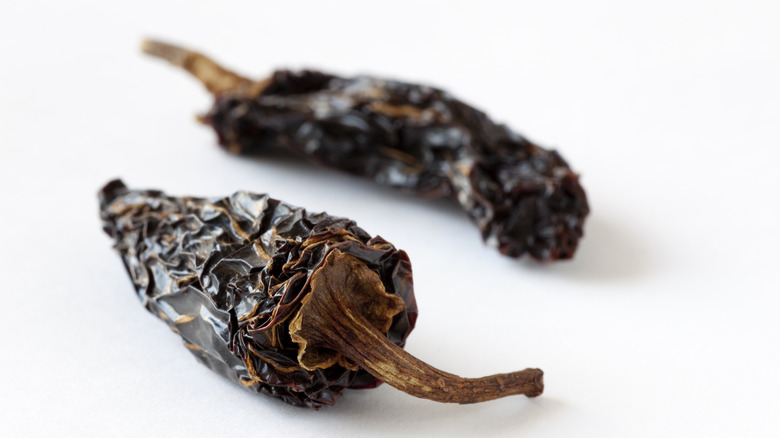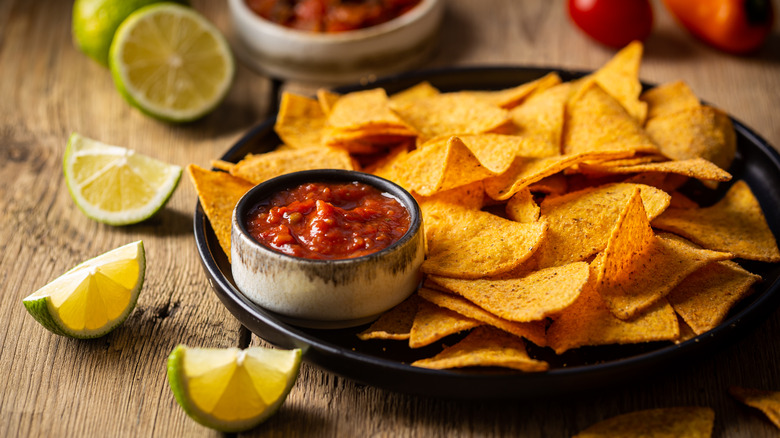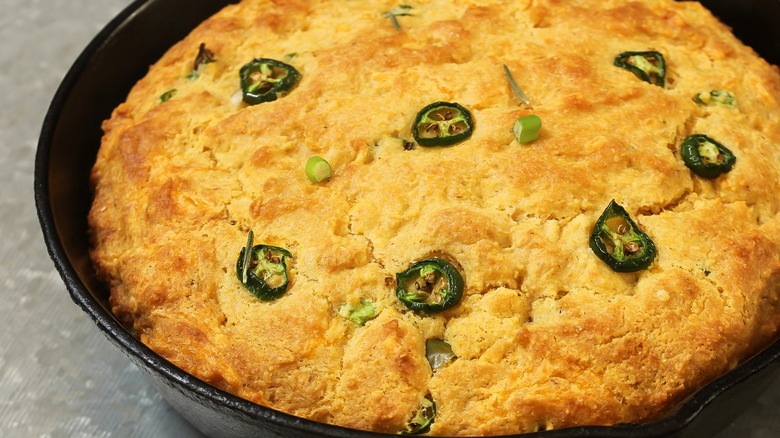11 Tips You Need When Cooking With Jalapeño
Jalapeños can be intimidating to eat, let alone cook with, especially for people afraid of spice. With these tips, the world's most popular chile can add a variety of different flavors or heat depending on the dish. Green and red jalapeño, or xalapeño, has been cultivated in Mexico for centuries and has deep roots in the traditional cuisine of the region. It's not much of a surprise that the original recipes and pickled peppers of the old country have spread to be embraced by cooks of all cultures. From home kitchens to ballparks, in fire-roasted salsa recipes, toppings, and even desserts, these chile peppers are as diverse as the palettes that consume them, and it's all in the preparation.
They aren't pricey either, and whether raw or cooked, sliced or diced, you can spice up your life if only an extra little bit. And make sure to wash your hands before using the bathroom or putting in contacts after touching these bad boys.
Pick a pepper with the right heat
Jalapeños range from 2,500 to 8,000 on the Scoville scale, quite the nuance to spot in a grocery store without chopping them up. Luckily, humans have learned to tell apart some of the spicier peppers from the variation in color. Peppers are often picked before they are ripe, and so the classic green jalapeño marketed to us isn't fully grown. It's lighter in spice and heavy in flavor and perfect for multitudes of dishes, from salsas to jalapeño poppers.
There are a few ways to tell how hot a jalapeño is. The hottest and oldest of these peppers are red. The younger the pepper, the milder. Another way to see the age in these chile peppers is the amount of stress. The more lines on the green peppers, the older and spicier. A smooth glossy, green pepper is young.
Regardless, there is a variety of spice levels from where and how the crop is cultivated. The weather and soil conditions can have a lot of influence on the amount of flavor and heat. When fresh produce isn't an option, canned jalapeños are perfect for packing a punch, although keep in mind that the juice they are packed in might burn your hands a bit.
Seed your peppers
Seeding peppers can be a great way to mix up the flavor profile. The seeds contain a good portion of the pepper's capsaicin which is an oil that rests in the membrane of the pepper and induces the burning sensations we get while eating a spicy chile causing teary-eyed excessive milk drinking. Capsaicin can also irritate external skin, so some recommend seeding jalapeños with gloves on, while others embrace that sensation or dissect precisely enough to forgo protection. Per reporting by the Washington Post, capsaicin will go right through latex gloves, so keep this in mind.
Wash the pepper and slice off only the top stemmed part of the pepper enough to see the seeds inside. Then, use a spoon or knife to scoop out the seeds and scratch out the interior of the pepper. Once your pepper is prepped in this way, cooking can begin. This is an extremely helpful step for stuffed peppers or jalapeño poppers. Wash your hands after dealing with them, even if wearing gloves. Plenty of recipes call for seeding as a starting point for your prep.
Try charing jalapeños
A great way to highlight any ingredient without leaving it raw is to char it. There is almost nothing better than those subtle burn marks on veggies from throwing them on the grill. This process releases oils and aromas that would otherwise go unnoticed. In some Southern states, roasting and charring pepper is so common that the grocery stores roast in the parking lot during the harvests.
A good first step is to seed the jalapeño peppers. Either leave them whole or slice them in half before putting them on the grill (without letting them fall through the topper) until they get a nice black char on one side. Turn as necessary. If it's too cold outside to grill or it isn't an option, try a fireside char or use a kitchen torch if one is handy. These peppers go great with minimal seasoning. Maybe only a little salt to taste, although they can be a good addition to any sandwich or steak. It's an easy way to add a lot of flare.
Use as a garnish
Jalapeños can be a diverse and practical garnish, whether that be as a topper on a salad or for an addition to a spicy cocktail one using tequila or a smoky mezcal. Get creative with a garnish. Just a slice of a seeded or unseeded jalapeño is a sufficient way to add some color to a meal or drink, plus a good amount of flavor and aroma. Throw a slice straight into a cocktail or use it as a rim rub. Sweetened peppers, pickled peppers, and other preserved forms also make a complex garnish to add layers to your beverage.
Garnishes can be fun and creative, but don't let them take away from a perfectly good recipe. They should enhance rather than deplete. It's easy for spicy ingredients to steal the show, so less is more. But don't let that stop you from experimenting.
Pickle Your Peppers
Pickling jalapeños is a terrific way to preserve fresh produce and add flavor to certain dishes. They can be sweet or spicy, or savory. They can be candied and eaten as a snack or used as a condiment. The different ways to pickle peppers are endless and vary from culture to culture. For instance, The Los Angeles Times reported about a once-thriving pickled jalapeño factory in Xalapa, Mexico, that perfected its historical recipe using vinegar, garlic, carrots, laurel leaves, onions, and other seasonings.
In Texas, people have embraced the cuisine with their own sweeter versions, like cowboy candy which uses sugar and apple cider vinegar. Pickling can take time. Some people boil it down to science, while others just throw things together. Some let their pickled jars ferment, and others do short-term pickles that have to be refrigerated. Just make sure to keep a couple of jars handy.
Use jalapeños sparingly
Jalapeños peppers have a whole lot of flavor in them already, and leveling them to other ingredients is ideal for making them stand out in a way that doesn't burn too much. It can be simple, done just by dicing them and adding them to chili or by throwing a few seeds into a salsa. The classic rule of thumb is that you can always add more but can't always take it out. It's better to have a well-proportioned spice ratio than too much, leaving guests with runny noses looking for tissues. It may only take one pepper or even half of pepper to get the perfect heat. Certain ingredients can offset that spice, like vinegar and lime juice.
A jalapeño-lime three bean salad is a perfectly acceptable and easy way to incorporate jalapeños without reinventing the wheel. They can give just about any raw recipe a nice Southwestern flare. Throw a few slices on a pizza or a diced tablespoon in an omelet. It can make all the difference.
Stuff your peppers
Looking for a good appetizer? Try stuffing your peppers for some easy nuanced flavor. There are many ways to stuff a pepper. Use cheese, meats, or chutney. A classic jalapeño popper can go a long way, and while some prefer a breaded and fried version, others just stuff the pepper and wrap it in bacon before tossing it on a grill. The additional cream cheese and bacon enhance the pepper's natural flavor while taming some fire. A broiled jalapeño popper recipe is a sure way to dress up your peppers in an amazing way. This one is fairly close to a cheesy stuffed baked potato.
This recipe calls for seeded, dressed, halved peppers filled with cooked bacon, cream, cheddar cheese, chives, onion and garlic powder, and a little bit of salt. Throw them in the broiler on low heat until the top layer of cheese bubbles and browns. Then, feel free to add a garnish and a side of ranch.
Try stuffing whole peppers by cutting the outside of the top of the pepper and pulling out all the seeds before stuffing and cooking all the goodness inside. This technique takes practice but saves time and your burning hands in the process. Canned and pickled jalapeños are a great option for this technique, but wear gloves while prepping them — you don't want to accidentally rub your eye later with traces of the juice.
Try frying jalapeños
Scared of some spice? Nothing a little batter can't fix. Anything fried tastes better; just ask a fan of bar fare or carnival food. So, seed these peppers, coin, halve, or keep them whole and toss them in batter before a stint in vegetable oil. Frying peppers can create a great mix of texture, layering the soft skin of the jalapeño and the crunch of the crispy exterior. They are a great addition to nonchalant cocktail parties or cookouts.
Frying can be a very rewarding way to cook. It can be exciting to create a batter or breading and use it as a base for a meal. But it can also be intimidating if your only experience is from crackling bacon grease and singeing forearms. So it's better to be cautious. Keep an eye on the oil and the heat. Don't walk away from the stove and drop in the coated peppers softly.
If that all sounds like too much, skip the hot oil. You've got other options. Try this healthier recipe for oil-free air-fryer jalapeño poppers. You'll still pack it all in, and the meal offers a great crunch; halved peppers and panko, along with other savory fixings, turn a simple chili into a delectable snack.
Cook with older jalapeño
A great way to enhance the flavor of any savory meal is to use an older variety of jalapeño that has been dried, hence the infamous chipotle. The difference between a jalapeño and a chipotle pepper is age and whether or not they were introduced to a smoker. Chipotle is the jalapeño that ripens long enough to turn red and be dried. It's no easy task. For instance, making one pound of chipotle peppers can take ten pounds of jalapeños. Some are left dry and smoked, and some become canned chipotle peppers with adobo sauce, which can add tangy, earthy variety to any meal. Add a can of adobo peppers to a pot roast and let it smell the house up something wonderful.
Chipotle peppers can often be found canned at the grocery store. They not only have more heat than the jalapeño but also have a bit of sweetness that comes out, which can add more flavor than just spice. Try adding them into barbecue recipes for that sweet heat or on to some grilled chicken or skirt steak for an extra kick on taco night.
Make salsa
There's nothing better than fresh salsa on a warm day. It can be refreshing, sweet, and spicy. Really, it can be whatever you want. If you're feeling the new-age urge to toss some fruit in the blender, feel free, but sometimes, it's best to stick to the classics. A charred tomato salsa will most definitely kick up those Southwestern flavors which add so much smoky goodness.
Heat a cast-iron or the grill and char the veggies until they get those beautiful black streaks, and you hear the neighbors say, "What smells so dang good?" Then, throw the charred vegetables into a food processor until they are the preferred texture. Some like it chunky, others like a little more watered-down picante style. It's a personal preference. Add some salt and cilantro, add enough to make two batches, and compare one with jalapeños and another with chipotle peppers. Jar and date what extras you have and put them in the refrigerator for safekeeping.
If a food processor isn't available and you don't mind a chunkier salsa, try dicing these peppers up with some sweet plum tomatoes for a beautiful addition to any snack, platter, or meal.
Try baking with jalapeños
Jalapeño cornbread isn't just a great side dish for a multitude of Southern delicacies. It embodies a whole culture. It's a phenomenon in the South bordering the pastry and BBQ landscape. A special and diverse dish for many, if not every occasion. Cornbread is so popular because its simple ingredients bear an exuberant amount of flavor. It is a culinary masterpiece, and the right amount of spice enhances that sweet and savory flavor. Dress up your cornbread with some sweet honey butter or some jalapeño jam. Make it more dessert-forward with added sugar, or use less for a savory side dish.
Consider a cast-iron jalapeño cornbread that returns the recipe to its roots with some added creamy cheese. The recipe calls for a moderately hot oven and using the stovetop to warm up butter for your wet ingredients and preheat the cast-iron pan. Stone-ground cornmeal adds a rustic flavor when combined with the biting flavors of green onion and jalapeño.
